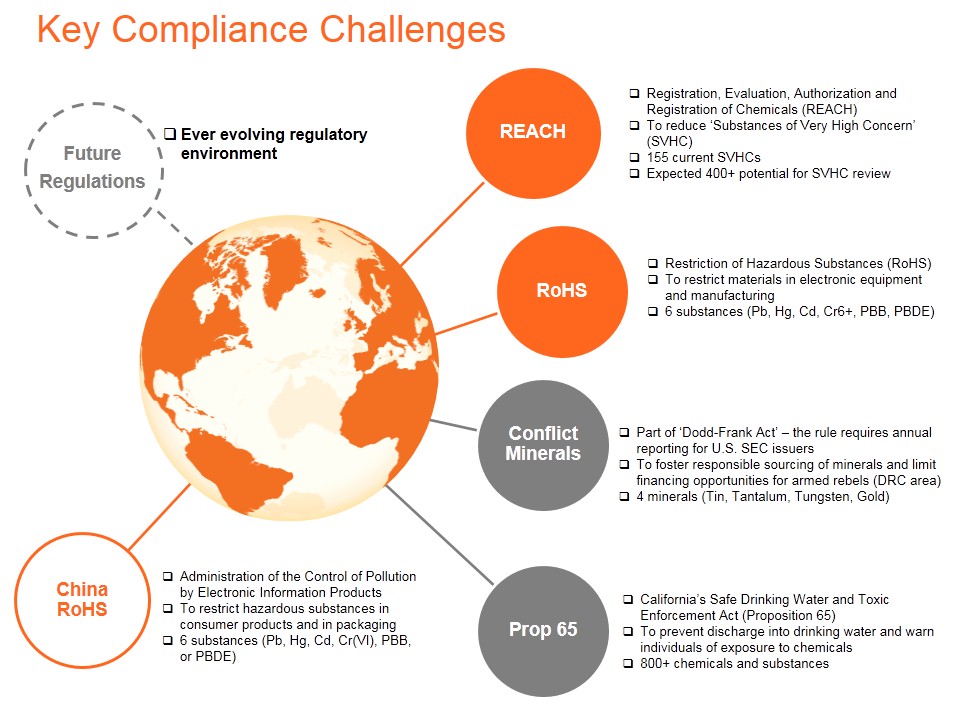Material Declaration
Governments around the world are focusing on restricting and eliminating the presence of hazardous materials in products and packaging from the environment to improve the sustainability of our planet. Therefore, there has been an increase in health and environmental regulatory requirements passed and proposed by different jurisdictions around the world. These regulations mandate compliance by manufacturers, suppliers, retailers, and distributors across the globe and include the following:

As a leading manufacturer of security technologies products and a responsible corporate citizen, Allegion is committed to environmental sustainability and promoting a cleaner ecosystem. Our goal is to design products with awareness of environmental impact, collaborate with our supply chain to source responsibly, and expect for all of Allegion’s suppliers to meet or exceed these same regulations and standards. Furthermore, Allegion is devoted to the manufacturing and distribution of products that comply with global governmental regulations (United States, Asia and Europe) with regards to restricted hazardous chemical use, reporting of substance of very high concerns (SVHCs) and product safety labeling and notification.
Allegion is aware of and committed to meeting the obligations imposed by these regulations and directives by:
- Actively developing programs with effective processes and a centralized data management system to gather information about our products
- Working with product development to incorporate regulatory restrictions in current and future designs
- Collaborating with our suppliers to secure updated product content compliance information
- Monitoring new regulatory requirements and updates
It is Allegion’s intent to offer products that are compliant with these regulatory mandates. We will continue to work with our customers, vendors and suppliers to ensure that our products remain compliant with the latest changes and updates to the regulatory requirements and directives. Below are more details about the materials compliance regulations that Allegion faces:
REACH
The Registration, Evaluation, Aurthorization and Restriction of Chemicals (REACH) regulation in European Union imposes registration requirements of manufacturers and importers of chemical substances classified as Substances of Very High Concern (SVHC). Article 57 of the regulation outlines the properties of the SVHCs chemicals, and includes:
- CMR – Carcinogens, Mutagens, or toxic to Reproduction (e.g., Lead chromate, Cadmium, etc.)
- PBT – Persistent, Bioaccumulative, and Toxic to the environment (e.g., Alkanes, Anthracene, etc.)
- vPvB – very Persistent and very Bioaccumulative in the environment (e.g., Chlorinated Paraffins, DecaBDE)
- Equivalent Level of Concern (e.g., Cadmium oxide, 4-Nonylphenol,etc.)
The candidate list now includes 155 Substances of Very High Concern (SVHC’s) and can be found at http://echa.europa.eu/candidate-list-table. Below is a table with the most frequent uses of the materials (this is a non-exhaustive list):
| Impacted Products | Most Frequent Uses | |
|---|---|
|
|
Per review of Article 3(3) of the REACH regulation, Allegion has determined our products to fall under the definition of an “article” or an object which during production is given a special shape, surface or design which determines its function to a greater degree than does its chemical composition. Article 3(3) requires Suppliers of the articles to:
- Inform the receipient of the article if an SVHC is present in those articles above a concentration of 0.1% or 1000ppm weight-by-weight, the name of the SVHC, and provide instructions of safe use, if applicable.
- Respond to a consumer request within 45 days of the receipt of the request
RoHS
RoHS 3 (EU Directive 2015/863), restricts the use of several hazardous substances in electrical and electronic equipment. There are currently four (4) additional substances under review for inclusion into the RoHS restricted list.
Substances | Uses |
|---|---|
| Cadmium (0.01%) | Electronic equipment, car batteries, metal coatings, pigments |
| Lead | Solder, lead-acid batteries, electronic components, cable sheathing |
| Mercury | Batteries, switches, and thermostats, and fluorescent lamps |
| Hexavalent chromium | Anti-corrosion and conversion coatings, dyes, and pigments |
| Polybrominated biphenyls (PBB) | Flame retardants |
| Polybrominated diphenyl ethers (PBDE) | Flame retardants |
| Bis(2-ethylhexyl) phthalate (DEHP) | PVC and vinyl insulation on electrical wires |
| Butyl benzyl phthalate (BBP) | PVC and vinyl insulation on electrical wires |
| Dibutyl phthalate (DBP) | PVC and vinyl insulation on electrical wires |
Diisobutyl phthalate (DIBP) | PVC and vinyl insulation on electrical wires |
Allegion will continue working with our suppliers to review our products for any changes to our compliance status with respect to the RoHS updates.
Proposition 65
This directive, The California Safe Drinking Water and Toxic Enforcement Act (Prop. 65), was enacted in Nov. 1986, and requires the state of California to publish and update a list of chemicals known to cause cancer or reproductive toxicity and to prescribe a minimum threshold for those chemicals of concern. This list contains over 800 chemicals and was last updated June 4, 2014 and can be found at http://oehha.ca.gov/prop65/getNSRLs.html
Materials | Most Frequent in Litigation |
|---|---|
|
|
The Office of Environmental Health Hazard Assessment (OEHHA) has established safe harbor levels (levels of exposure that trigger the warning requirement) for some, but not all, listed chemicals.
For chemicals with no safe harbor levels, a company must notify the public with a “clear and reasonable” warning before knowingly and intentionally exposing anyone to a listed chemical unless the exposure poses “no significant risk of cancer” (as defined by the Act) or is significantly below levels observed to cause defects or other reproductive harm.
The warning message must include the following language:
For consumer products that contain a chemical known to the state to cause cancer:
WARNING: This product contains a chemical known to the State of California to cause cancer.
For consumer products that contain a chemical known to the state to cause reproductive toxicity:
WARNING: This product contains a chemical known to the State of California to cause birth defects or other reproductive harm.
Contact us
Have a sustainability question? We're here to help.




